Sustainability and Employability in the Time of COVID-19. Youth, Education and Entrepreneurship in EU Countries
Abstract
:1. Introduction
1.1. Economic Systems in the Time of the COVID-19 Pandemic: A Brief Literature Review
1.2. Rethinking Sustainability and Employability: A Theoretical Approach
2. Research Methods
2.1. Research Framework: Objectives, Questions and Hypothesis
2.2. Data, Methods and Quantitative Design
3. Results
3.1. Employability and Economic Imbalances in the EU-28
3.2. Youth, Education and Economic Freedom: A Quantitative Model for Predicting Employability
3.3. Gender and Employability in EU-28
4. Discussion
5. Conclusions
Author Contributions
Funding
Data Availability Statement
Conflicts of Interest
References
- Buzzi, C.; Tucci, M.; Ciprandi, R.; Brambilla, I.; Caimmi, S.; Ciprandi, G.; Marseglia, G.L. The psycho-social effects of COVID-19 on Italian adolescents’ attitudes and behaviors. Ital. J. Pediatrics 2020, 46, 69. [Google Scholar] [CrossRef] [PubMed]
- Cano, O.B.; Morales, S.C.; Bendtsen, C. COVID-19 Modelling: The Effects of Social Distancing. Interdiscip. Perspect. Infect. Dis. 2020, 2020, 2041743. [Google Scholar] [CrossRef]
- Silva, P.C.L.; Batista, P.V.C.; Lima, H.S.; Alves, M.A.; Guimaraes, F.G.; Silva, R.C.P. COVID-ABS: An Agent-Based Model of COVID-19 Epidemic to Simulate Health and Economic Effects of Social Distancing Interventions. Ch. Sol. Fract. 2020, 139, 110088. [Google Scholar] [CrossRef] [PubMed]
- Razai, M.S.; Oakeshott, P.; Kankam, H.; Galea, S.; Lampard, H.S. Mitigating the psychological effects of social isolation during the COVID-19 pandemic. BMJ 2020, 369, m1904. [Google Scholar] [CrossRef] [PubMed]
- Marroquín, B.; Vine, V.; Morgan, R. Mental health during the COVID-19 pandemic: Effects of stay-at-home policies, social distancing behavior, and social resources. Psychiatry Res. 2020, 293, 113419. [Google Scholar] [CrossRef]
- Chen, T.; Rong, J.; Peng, L.; Yang, J.; Cong, G.; Fang, J. Analysis of Social Effects on Employment Promotion Policies for College Graduates Based on Data Mining for Online Use Review in China during the COVID-19 Pandemic. Health. 2021, 9, 846. [Google Scholar] [CrossRef] [PubMed]
- Altig, D.; Baker, S.; Barrer, J.M.; Bloom, N.; Bunn, P.; Chen, S.; Davis, S.J.; Leather, J.; Meyer, B.; Mihaylov, E.; et al. Economic uncertainty before and during the COVID-19 pandemic. J. Public Econ. 2020, 191, 104274. [Google Scholar] [CrossRef] [PubMed]
- Suppawittaya, P.; Yiemphat, P.; Yasri, P. Effects of Social Distancing, Self-Quarantine and Self-Isolation during the COVID-19 Pandemic on People’s Well-Being, and How to Cope with It. Int. J. Sci. Healthc. Res. 2020, 5, 12–20. [Google Scholar]
- Baldwin, R.; di Mauro, B.W. Economics in the Time of COVID-19; CEPR Press: London, UK, 2020. [Google Scholar]
- Sandeep, K.M.; Maheshwari, V.; Prabhu, J.; Prasanna, M.; Jayalakshmi, P.; Suganya, P.; Benjula, A.M. Social economic impact of COVID-19 outbreak in India. Int. J. Pervasive Comput. Commun. 2020, 16, 309–319. [Google Scholar] [CrossRef]
- Keiner, M. The Future of Sustainability; Springer: Dordrecht, The Netherlands, 2006. [Google Scholar]
- Mofijur, M.; Fattah, I.R.; Alam, M.A.; Islam, A.S.; Ong, H.C.; Rahman, S.A.; Najafi, G.; Ahmed, S.F.; Uddin, M.A.; Mahlia, T.M.I. Impact of COVID-19 on the social, economic, environmental and energy domains: Lessons learnt from a global pandemic. Sustain. Prod. Cons. 2021, 26, 343–359. [Google Scholar] [CrossRef]
- Brodeur, A.; Gray, D.; Islam, A.; Bhuiyan, S. A literature review of the economics of COVID-19. J. Econ. Surv. 2021, 35, 1007–1044. [Google Scholar] [CrossRef] [PubMed]
- Tisdell, C.A. Economic, social and political issues raised by the COVID-19 pandemic. Econ. Anal. Policy 2020, 68, 17–28. [Google Scholar] [CrossRef] [PubMed]
- Nadeem Ashraf, B. Economic impact of government interventions during the COVID-19 pandemic: International evidence from financial markets. J. Behav. Exp. Financ. 2020, 27, 100371. [Google Scholar] [CrossRef] [PubMed]
- Li, Y.; Mutchler, J.E. Older Adults and the Economic Impact of the COVID-19 Pandemic. J. Aging Soc. Policy 2020, 32, 477–487. [Google Scholar] [CrossRef] [PubMed]
- Buheji, M.; da Costa Cunha, M.; Beka, G.; Mavrić, B.; De Souza, Y.L.; da Costa Silva, S.S.; Hanafi, M.; Yein, T.C. The Extent of COVID-19 Pandemic Socio-Economic Impact on Global Poverty. A Global Integrative Multidisciplinary Review. Am. J. Econ. 2020, 10, 213–224. [Google Scholar] [CrossRef]
- McBride, O.; Murphy, J.; Shevlin, M.; Gibson-Miller, J.; Hartman, T.K.; Hyland, P.; Levita, L.; Mason, L.; Martinez, A.P.; McKay, R.; et al. Monitoring the psychological, social, and economic impact of the COVID-19 pandemic in the population: Context, design and conduct of the longitudinal COVID-19 psychological research consortium (C19PRC) study. Int. J. Methods Psychiatr. Res. 2021, 30, e1861. [Google Scholar] [CrossRef] [PubMed]
- Hevia, C.; Neumeyer, A. A Conceptual Framework for Analyzing the Economic Impact of COVID-19 and its Policy Implications. UNDP LAC C19 PDS 2020, 1, 29. [Google Scholar]
- Rahman, A.; Zaman, N.; Taufiq Asyhari, A.; Al-Turjman, F.; Bhuiyan, Z.A.; Zolkipli, M.F. Data-driven dynamic clustering framework for mitigating the adverse economic impact of COVID-19 lockdown practices. Sustain. Cities Soc. 2020, 62, 102372. [Google Scholar] [CrossRef]
- Ceylan, R.F.; Ozkan, B.; Mulazimogullari, E. Historical evidence for economic effects of COVID-19. Eur. J. Health Econ. 2020, 21, 817–823. [Google Scholar] [CrossRef]
- Blackburn, W.R. The Sustainability Handbook: The Complete Management Guide to Achieving Social, Economic, and Environmental Responsibility; Earthscan: London, UK, 2007. [Google Scholar]
- López, R.; Toman, M.A. Economic Development and Environmental Sustainability. New Policy Options; Oxford University Press: New York, NY, USA, 2006. [Google Scholar]
- Wüstenhagen, R.; Hamschmidt, J.; Sharma, S.; Starik, M. Sustainable Innovation and Entrepreneurship. New Perspectives in Research on Corporate Sustainability; Edward Elgar: Cheltenham, UK, 2008. [Google Scholar]
- Hák, T.; Moldan, B.; Dahl, A.L. Sustainability Indicators. A Scientific Assessment; Island Press: Washington, WA, USA, 2007. [Google Scholar]
- Edwards, A.R. The Sustainability Revolution. Portrait of a Paradigm Shift; New Society Publishers: Gabriola Island, BC, Canada, 2005. [Google Scholar]
- Bell, S.; Morse, S. Sustainability Indicators Measuring the Immeasurable? 2nd ed.; Earthscan: London, UK, 2008. [Google Scholar]
- Steger, U. The Business of Sustainability. Building Industry Cases for Corporate Sustainability; Palgrave Macmillan: New York, NY, USA, 2004. [Google Scholar]
- Hawkins, D.E. Corporate Social Responsibility. Balancing Tomorrow’s Sustainability and Today’s Profitability; Palgrave Macmillan: New York, NY, USA, 2006. [Google Scholar]
- Choucri, N.; Mistree, D.; Haghseta, F.; Mezher, T.; Baker, W.R.; Ortiz, C.I. Mapping Sustainability Knowledge e-Networking and the Value Chain; Springer: Dordrecht, The Netherlands, 2007. [Google Scholar]
- Dunphy, D.; Benveniste, J.; Griffiths, A.; Sutton, P. Sustainability. The Corporate Challenge of the 21st Century; Allen & Unwin: Crows Nest, Australia, 2000. [Google Scholar]
- Adams, C.A.; Abhayawansa, S. Connecting the COVID-19 pandemic, environmental, social and governance (ESG) investing and calls for ‘harmonisation’ of sustainability reporting. Crit. Perspect. Account. 2021, in press. [Google Scholar] [CrossRef]
- Barbier, E.B.; Burgess, J.C. Sustainability and development after COVID-19. World Dev. 2020, 135, 105082. [Google Scholar] [CrossRef] [PubMed]
- Sarkis, J. Supply chain sustainability: Learning from the COVID-19 pandemic. IJOPM 2021, 41, 63–73. [Google Scholar] [CrossRef]
- Neumayer, E. Human Development and Sustainability. J. Hum. Dev. Capab. Multi-Discip. J. People-Cent. Dev. 2012, 13, 561–579. [Google Scholar] [CrossRef]
- Neumayer, E. The human development index and sustainability—A constructive proposal. Ecol. Econ. 2001, 39, 101–114. [Google Scholar] [CrossRef]
- Wilkinson, A.; Hill, M. The sustainability debate. IJOPM 2001, 21, 1492–1502. [Google Scholar] [CrossRef]
- Spreitzer, G.; Porath, C.; Gibson, C. Toward human sustainability: How to enable more thriving at work. Organ. Dyn. 2012, 41, 155–162. [Google Scholar] [CrossRef]
- Nilashi, M.; Rupani, P.F.; Rupani, M.M.; Kamyab, H.; Shao, W.; Ahmadi, H.; Rashid, T.A.; Aljojo, N. Measuring sustainability through ecological sustainability and human sustainability: A machine learning approach. J. Clean. Prod. 2019, 240, 118162. [Google Scholar] [CrossRef]
- Šlaus, I.; Jacobs, G. Human Capital and Sustainability. Sustainability 2011, 3, 97–154. [Google Scholar] [CrossRef] [Green Version]
- Nations, U. About the Sustainable Development Goals—United Nations Sustainable Development. United Nations. Available online: www.un.org/sustainabledevelopment/sustainable-development-goals/ (accessed on 15 September 2021).
- Hakovirta, M.; Denuwara, N. How COVID-19 Redefines the Concept of Sustainability. Sustainability 2020, 12, 3727. [Google Scholar] [CrossRef]
- Bansal, P.; Grewatsch, S.; Sharma, G. How COVID-19 Informs Business Sustainability Research: It’s Time for a Systems Perspective. J. Manag. Stud. 2021, 58, 602–606. [Google Scholar] [CrossRef]
- Schaltegger, S. Sustainability learnings from the COVID-19 crisis. Opportunities for resilient industry and business development. SAMPJ 2021, 12, 889–897. [Google Scholar] [CrossRef]
- Hamilton, J. The Strategic Change Matrix and Business Sustainability across COVID-19. Sustainability 2020, 12, 6026. [Google Scholar] [CrossRef]
- Cawthorn, D.M.; Kennaugh, A.; Ferreira, S.M. The future of sustainability in the context of COVID-19. Ambio 2021, 50, 812–821. [Google Scholar] [CrossRef] [PubMed]
- Goffman, E. In the wake of COVID-19, is glocalization our sustainability future? Sustain. Sci. Pract. Policy 2020, 16, 48–52. [Google Scholar] [CrossRef]
- Ikram, M.; Zhang, Q.; Sroufe, R.; Ferasso, M. The Social Dimensions of Corporate Sustainability: An Integrative Framework Including COVID-19 Insights. Sustainability 2020, 12, 8747. [Google Scholar] [CrossRef]
- Hörisch, J. The relation of COVID-19 to the UN sustainable development goals: Implications for sustainability accounting, management and policy research. SAMPJ 2021, 12, 877–888. [Google Scholar] [CrossRef]
- Spurk, D.; Straub, C. Flexible employment relationships and careers in times of the COVID-19 pandemic. J. Vocat. Behav. 2020, 119, 103435. [Google Scholar] [CrossRef]
- Hodder, A. New Technology, Work and Employment in the era of COVID-19: Reflecting on legacies of research. New Technol. Work. Employ. 2020, 35, 262–275. [Google Scholar] [CrossRef]
- Fana, M.; Torrejón Pérez, S.; Fernández-Macías, E. Employment impact of COVID-19 crisis: From short term effects to long terms prospects. J. Ind. Bus. Econ. 2020, 47, 391–410. [Google Scholar] [CrossRef]
- Webb, A.; McQuaid, R. Employment in the informal economy: Implications of the COVID-19 pandemic. IJSSP 2020, 40, 1005–1019. [Google Scholar] [CrossRef]
- Lord, P. Incentivising employment during the COVID-19 pandemic. Theory Pract. Legis. 2020, 8, 355–372. [Google Scholar] [CrossRef]
- Cohen, G.D. Measuring employment during COVID-19: Challenges and opportunities. Bus. Econ. 2020, 55, 229–239. [Google Scholar] [CrossRef] [PubMed]
- Sakshaug, J.W.; Beste, J.; Coban, M.; Fendel, T.; Haas, G.C.; Hülle, S.; Kosyakova, Y.; König, C.; Kreuter, F.; Küfner, B.; et al. Impacts of the COVID-19 Pandemic on Labor Market Surveys at the German Institute for Employment Research. Surv. Res. Methods 2020, 14, 229–233. [Google Scholar]
- Cook, R.; Grimshaw, D. A gendered lens on COVID-19 employment and social policies in Europe. Eur. Soc. 2021, 23, 215–227. [Google Scholar] [CrossRef]
- Churchill, B. COVID-19 and the immediate impact on young people and employment in Australia: A gendered analysis. Gend. Work. Organ. 2021, 28, 783–794. [Google Scholar] [CrossRef]
- Gemelas, J.; Davison, J.; Keltner, C.; Ing, S. Inequities in Employment by Race, Ethnicity, and Sector during COVID-19. J. Racial Ethn. Health Disparities 2021, 8, 1–6. [Google Scholar] [CrossRef]
- Zhang, X.; Gozgor, G.; Lu, Z.; Zhang, J. Employment hysteresis in the United States during the COVID-19 pandemic. Econ. Res. 2021, 34, 3343–3354. [Google Scholar] [CrossRef]
- Tomaz, C.; Crane, L.; Decker, R.; Hamins-Puertolas, A.; Kurz, C. Tracking Labor Market Developments during the COVID19 Pandemic: A Preliminary Assessment; Finance and Economics Discussion Series (FEDS) Working Paper No. 2020-030; Board of Governors of the Federal Reserve System: Washington, DC, USA, 2020. [Google Scholar] [CrossRef]
- Gray, B.J.; Kyle, R.; Song, J.; Davies, A. Characteristics of those most vulnerable to employment changes during the COVID-19 pandemic: A nationally representative cross-sectional study in Wales. J. Epidemiol. Community Health 2020, 76, 8–15. [Google Scholar] [CrossRef]
- Madai Boukar, A.; Mbock, O.; Malambwe Kilolo, J.M. The impacts of the COVID-19 pandemic on employment in Cameroon: A general equilibrium analysis. Afr. Dev. Rev. 2021, 33, S88–S101. [Google Scholar] [CrossRef]
- Taeho Kim, A.; Hwan Kim, C.; Tuttle, E.S.; Zhang, Y. COVID-19 and the decline in Asian American employment. Res. Soc. Stratif. Mobil. 2021, 71, 100563. [Google Scholar] [CrossRef]
- Landivar, L.C.; Ruppanner, L.; Scarborough, W.J.; Collins, C. Early Signs Indicate That COVID-19 Is Exacerbating Gender Inequality in the Labor Force. Socius Sociol. Res. A Dyn. World 2020, 6, 2378023120947997. [Google Scholar] [CrossRef]
- European Statistical Office. EUROSTAT. Available online: https://ec.europa.eu/eurostat/data/database (accessed on 15 October 2021).
- The World Bank. The World Bank Indicators. Available online: https://data.worldbank.org/indicator (accessed on 20 October 2021).
- The Heritage Foundation. Index of Economic Freedom. Available online: https://www.heritage.org/index/ (accessed on 10 December 2021).
- United Nations Development Programme. UNDP-Human Development Index. Available online: http://hdr.undp.org/en/2020-report (accessed on 5 November 2021).
- Lupton, D. Contextualizing COVID-19. In The COVID-19 Crisis. Social Perspectives; Deborah Lupton, D., Willis, K., Eds.; Routledge: London, UK; New York, NY, USA, 2021; pp. 16–17. [Google Scholar]
- Trompenaars, F.; Hampden-Turner, C. Culture, Crisis and COVID-19: The Great Reset; Cambridge Scholars Publishing: Cambridge, UK, 2021. [Google Scholar]
- Mackenzie, D. COVID-19: The Pandemic That Never Should Have Happened and How to Stop the Next One; Hachette Books: New York, NY, USA, 2020; pp. 238–239. [Google Scholar]
- Nelson, P. Global Development and Human Rights. The Sustainable Development Goals and Beyond; University of Toronto Press: Toronto, ON, Canada, 2021. [Google Scholar]
- Pantea, M.C. Precarity and Vocational Education and Training; Palgrave Macmillan; Springer International Publishing AG: Gewerbestrasse, Switzerland, 2019. [Google Scholar]
- Kantola, J.; Lombardo, E. (Eds.) Gender and the Economic Crisis in Europe; Palgrave Macmillan; Springer International Publishing AG: Gewerbestrasse, Switzerland, 2017. [Google Scholar]
- Villa, P.; Smith, M. Policy in the Time of Crisis. Employment policy and gender equality in Europe. In Woman and Austerity; Maria, K., Gill, R., Eds.; Routledge: London, UK; New York, NY, USA, 2014; p. 289. [Google Scholar]
- European Union. EU Youth Strategy. Available online: https://europa.eu/youth/strategy_en (accessed on 12 December 2021).

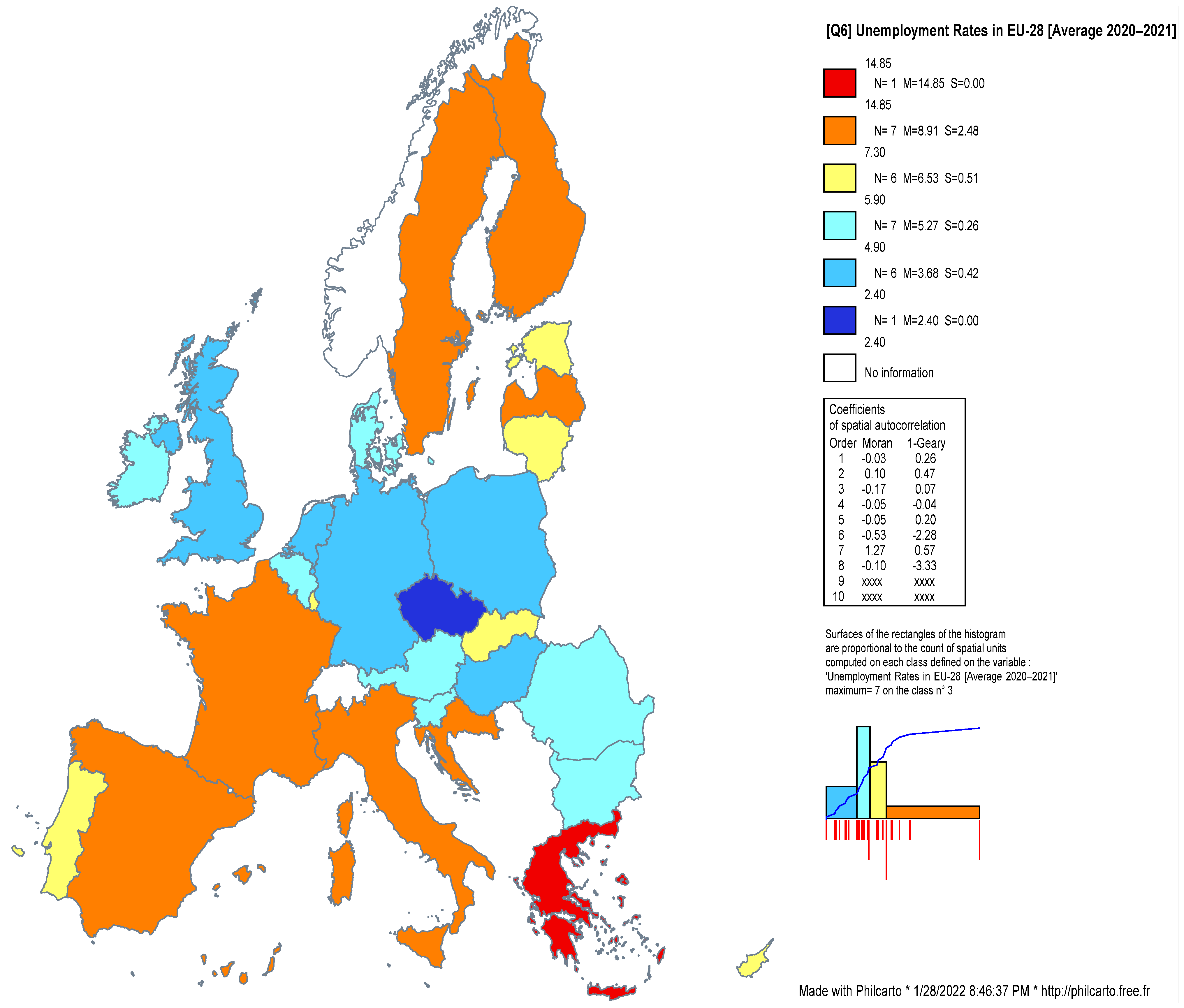
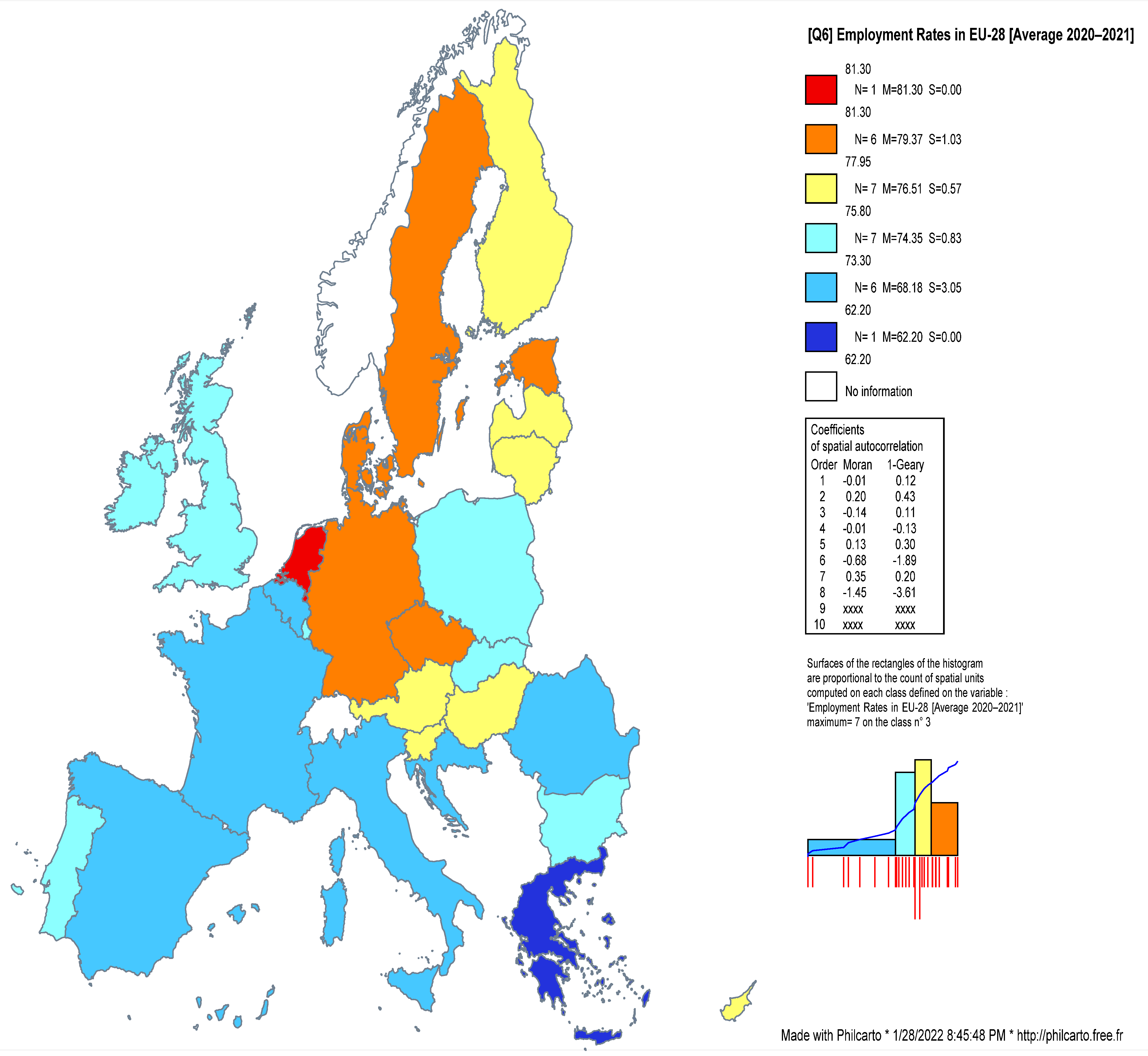

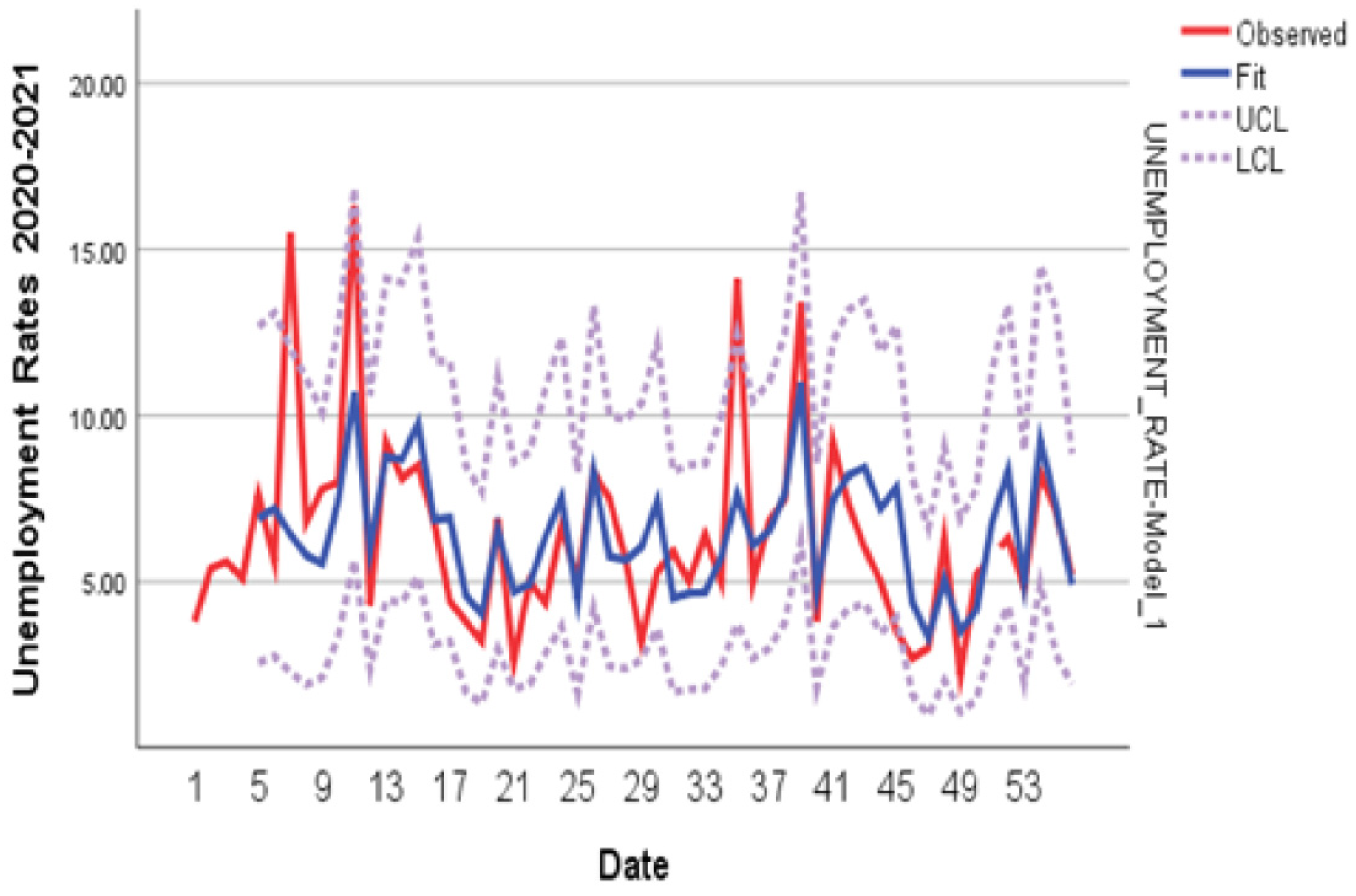
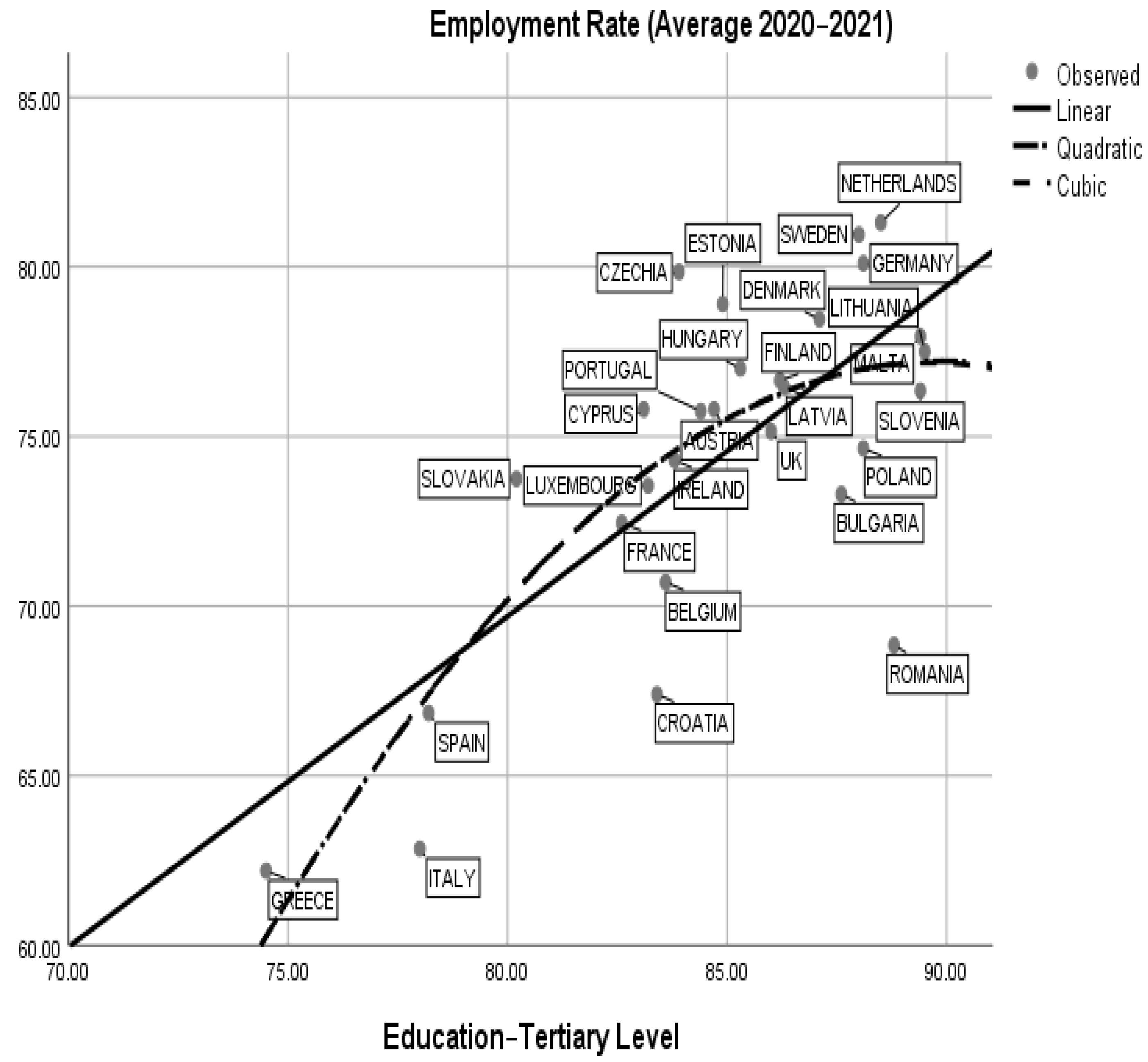
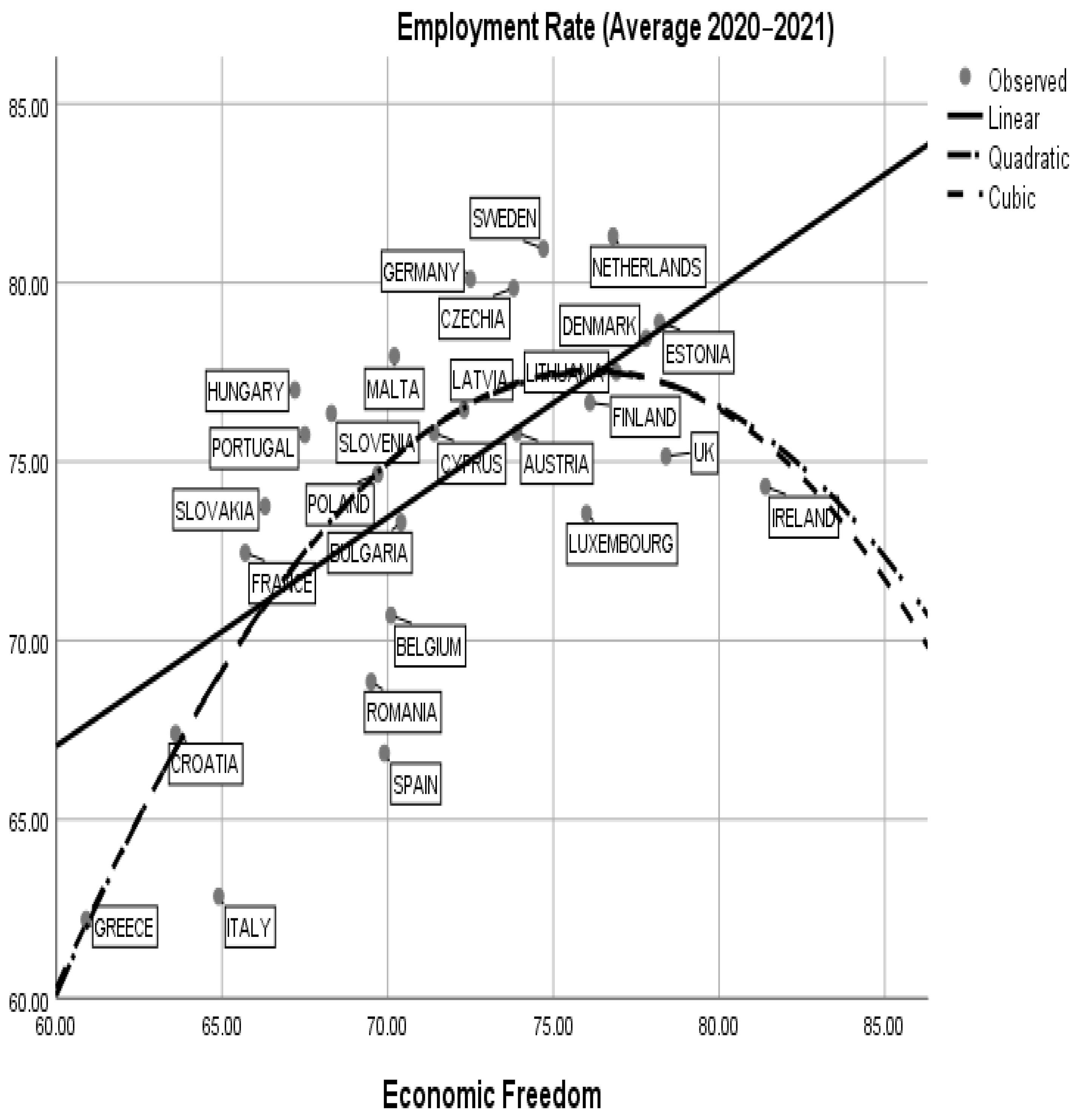


| Variable | Symbol | Scale | Source |
|---|---|---|---|
| ER | [0–100] | Eurostat [66] |
| UR | [0–100] | Eurostat |
| EG | [−n; +n] | World Bank [67] |
| IR | [−n; +n] | Eurostat |
| IP | [0–100] | Eurostat |
| MDY | [0–100] | Eurostat |
| ERW | [0–100] | Eurostat |
| ERPS | [0–100] | Eurostat |
| ERT | [0–100] | Eurostat |
| LM | [0–100] | Eurostat |
| LF | [0–100] | The Heritage Foundation [68] |
| BF | [0–100] | The Heritage Foundation |
| EF | [0–100] | The Heritage Foundation |
| HDI | [0–1] | United Nations Development Programme [69] |
| GINI | [0–1] | World Bank |
| Employment Rate 2020–2021 | Unemployment Rate 2020–2021 | Economic Growth | Inflation Rate | Economic Freedom | Gini Index | HDI | Material Deprivation—Young | ||
|---|---|---|---|---|---|---|---|---|---|
| Mean | 74.09 | 6.64 | −4.79 | 1.69 | 71.58 | 31.46 | 0.89 | 7.79 | |
| Median | 75.20 | 6.15 | −4.40 | 1.55 | 70.90 | 31.00 | 0.89 | 6.00 | |
| Mode | 67 | 3.80 | −6.30 | 0.60 | 60.90 | 25.20 | 0.89 | 1.90 | |
| Std. Deviation | 5.09 | 3.02 | 3.30 | 0.93 | 5.00 | 3.92 | 0.03 | 6.71 | |
| Variance | 25.99 | 9.15 | 10.93 | 0.86 | 25.09 | 15.37 | 0.00 | 45.08 | |
| Skewness | −0.98 | 1.61 | 0.85 | 0.46 | −0.08 | 0.13 | −0.37 | 2.07 | |
| Std. Error of Skewness | 0.32 | 0.32 | 0.31 | 0.31 | 0.31 | 0.31 | 0.31 | 0.44 | |
| Kurtosis | 0.50 | 3.09 | 2.35 | −0.66 | −0.64 | −0.46 | −0.57 | 4.02 | |
| Std. Error of Kurtosis | 0.63 | 0.63 | 0.62 | 0.62 | 0.62 | 0.62 | 0.62 | 0.87 | |
| Range | 21 | 13.70 | 16.70 | 3.50 | 20.50 | 16.20 | 0.14 | 27.20 | |
| Minimum | 61 | 2.60 | −10.80 | 0.30 | 60.90 | 24.20 | 0.82 | 1.90 | |
| Maximum | 82 | 16.30 | 5.90 | 3.80 | 81.40 | 40.40 | 0.96 | 29.10 | |
| Percentiles | 25 | 72.10 | 4.66 | −7.45 | 0.82 | 67.70 | 28.72 | 0.86 | 3.50 |
| 50 | 75.20 | 6.15 | −4.40 | 1.55 | 70.90 | 31.00 | 0.89 | 6.00 | |
| 75 | 77.80 | 7.80 | −2.92 | 2.45 | 76.07 | 34.77 | 0.93 | 8.70 | |
| Model | Standardized Coefficients | T | Sig. | Collinearity Statistics | ||
|---|---|---|---|---|---|---|
| Beta | Tolerance | VIF | ||||
| 1 | (Constant) | 86.6 | 42.105 | 0.000 | ||
| YOUNG PEOPLE | −0.786 | −6.484 | 0.000 | 1.000 | 1.000 | |
| 2 | (Constant) | 29.19 | 1.856 | 0.075 | ||
| YOUNG PEOPLE | −0.504 | −4.003 | 0.000 | 0.627 | 1.595 | |
| EDUCATION LEVEL TERTIARY | 0.462 | 3.676 | 0.001 | 0.627 | 1.595 | |
| 3 | (Constant) | 16.38 | 1.027 | 0.315 | ||
| YOUNG PEOPLE | −0.401 | −3.136 | 0.004 | 0.535 | 1.870 | |
| EDUCATION LEVEL TERTIARY | 0.408 | 3.382 | 0.002 | 0.599 | 1.671 | |
| ECONOMIC FREEDOM | 0.243 | 2.101 | 0.046 | 0.655 | 1.527 | |
Publisher’s Note: MDPI stays neutral with regard to jurisdictional claims in published maps and institutional affiliations. |
© 2022 by the authors. Licensee MDPI, Basel, Switzerland. This article is an open access article distributed under the terms and conditions of the Creative Commons Attribution (CC BY) license (https://creativecommons.org/licenses/by/4.0/).
Share and Cite
Gavriluță, N.; Grecu, S.-P.; Chiriac, H.C. Sustainability and Employability in the Time of COVID-19. Youth, Education and Entrepreneurship in EU Countries. Sustainability 2022, 14, 1589. https://doi.org/10.3390/su14031589
Gavriluță N, Grecu S-P, Chiriac HC. Sustainability and Employability in the Time of COVID-19. Youth, Education and Entrepreneurship in EU Countries. Sustainability. 2022; 14(3):1589. https://doi.org/10.3390/su14031589
Chicago/Turabian StyleGavriluță, Nicu, Silviu-Petru Grecu, and Horia Costin Chiriac. 2022. "Sustainability and Employability in the Time of COVID-19. Youth, Education and Entrepreneurship in EU Countries" Sustainability 14, no. 3: 1589. https://doi.org/10.3390/su14031589
APA StyleGavriluță, N., Grecu, S.-P., & Chiriac, H. C. (2022). Sustainability and Employability in the Time of COVID-19. Youth, Education and Entrepreneurship in EU Countries. Sustainability, 14(3), 1589. https://doi.org/10.3390/su14031589





